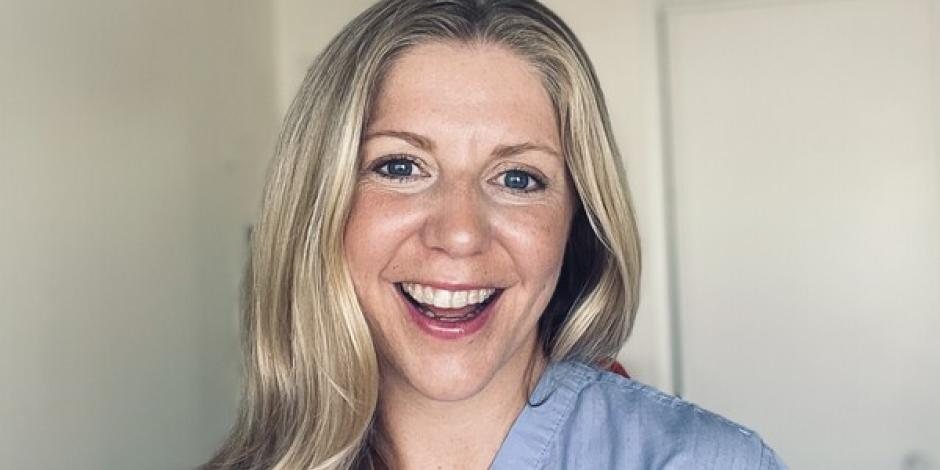Starten Sie den Audio-Text
Mit dem Audio-Player können Sie sich den Text anhören. Darunter finden Sie das Transkript.
Sion: Death and dying — how do these words make you feel? Many people are uncomfortable talking about the fact that life is finiteendlich, begrenztfinite. But avoiding a topic at all costs doesn’t make it go away. For those working in end-of-life care, death and dying are ever-present. Julie McFadden, also known as “Hospice Nurse Julie” on TikTok, is on a mission to normalize open conversations around death. When her book Nothing to Fear became a New York Times bestseller, it also became clear that people are interested in reading about the topic even if they don’t talk about it over dinner. Business Spotlight catch up with sb.sich mit jmdm. treffen; hier: mit jmdm. sprechencaught up with Julie McFadden to find out more about her career choice. Let’s start by hearing how Julie got into hospice work. In this first extract, you will hear Julie mention the “ICU (intensive care unit)IntensivstationICU,” which stands for “intensive care unit.”
Julie: You usually get really excited about becoming a nurse, and you have this whole plan in your head of what’s going to happen. Like, for two years, I’m going to work here, then I’m going to move here, then I’m going to do this. And that is what I had. I had a whole plan set up. I was going to be an ICU nurse, then go back to school, then get into anesthesia. And it sorelyschmerzlich, zutiefstsorely was flip sth. upside-downetw. auf den Kopf stellenflipped upside-down when I started actually being a nurse, and I was an ICU nurse, which is kind of the opposite of hospice. It’s critical-care nursingIntensiv(kranken)pflegecritical-care nursing. So, people are really sick, and we’re trying to keep them alive at all costs. And it’s an amazinggroßartigamazing thing most of the time. As the years went on, I think it took about two years, I started being like, “Oh, there’s a population of peoplehier: Patientenbelegungpopulation of people in the ICU that we should not be doing all of this stuff to try to keep them ‘alive.’” And I put that in air quotesAnführungszeichen(gebärde)air quotes because we really are — like, they would be dead otherwise and and they have no quality of life. They probably aren’t going to have quality of life. And we’re not really talking about that. So, that is when I started being like, “Listen. One, we’re all going to die. That’s a fact. Two, there are some people that have certain diseases or multiple diseases with age, where it’s, like, this is the end of life here. And if it’s the end of life, why are we having them in a hospital bed and not talking about it? And that is when I started being like, “There has to be a better way. And that way I think is hospice.”
Sion: Then, Julie spoke about her decision to talk about her work on social media.
Julie: I had a couple friends at the time whose parents were dying, and they were calling me because they’re my friends and they knew I was a hospice nurse, just to, like, talk about things and, like, figure sth. out (ifml.)hier: etw. erklärenfigure things out. They were kind of like, “How did I not know that you knew this stuff? This is crazy. I’ve never heard people talk about this before.” And one of my friends in particular was like, “You need to talk about this online. You need to start a podcast or do something.” And I didn’t really think much of it, ’cos I felt like, “I don’t. I have no desire to really do that.” But then, I went home to see my nieces who were, like, teenagers, and they were on TikTok. Again, I didn’t think anything of it. If anything, I was making fun of it. But I did get on TikTok because I was, like, wanting to see their dances, and they were, like, teaching me how to use it. And then, I actually started watching TikTok, and TikTok had, like, a bunch (ifml.)Gruppebunch of people my age (I’m 40 ), who were talking about, like, gardening and cooking, and, like, space. And I was like, “Oh, this is so cool.” So I literallybuchstäblichliterally made probably five videos. And I think, like, the fourth video in, it go viralsich rasant schnell im Netz verbreitenwent viral, and I got, like, 10,000 followers overnight. And then, by the end of the month, I had, like, 100,000 followers. By the end of the year, I had a million followers, and then a publishing company reach out to sb. (US)jmdn. kontaktierenreached out to me. Which is how I have a book and a workbook. Now, I have a YouTube channel, and the only thing I can say is, it felt really organic. I feel like I didn’t have to, like, work hard for this stuff to happen. So, it makes me feel like people, even though we all say we don’t want to talk about it or we feel uncomfortable talking about it, people want to watch it because they are. So, I don’t know if it’s, like, the screen that gives them like some removal.
Sion: Julie then explained some of the different roles in hospice care. In this extract, Julie uses the acronym “RN,” which stands for “registeredhier: staatlich anerkanntregistered nurse.” She also talks about “charting,” which is the process of preparing the necessary documentation for each patient for Medicareöffentliche USGesundheitsfürsorge für über 65-Jährige oder Menschen mit BehinderungMedicare, the U.S. federal health insurance for those over 65 or those under 65 with specific disabilities or conditions.
Julie: So, there’s [non-standard] different roles in hospice. You can be the RN case manager, which means you are managing a caseloadAnzahl von Fällencaseload of patients, usually 15 — 12 to 15. And if you’re doing that, your day is spent making, like, visits to all the patients throughout the week, right? If you do what I do, I do a lot of admissionAufnahmeadmission work, meaning, like, I’m the first nurse they see when they’re coming on to hospice. I spend almost half of the day with the family and the patient, educate sb.hier: jmdn. unterweiseneducating them, preparing their house, getting everything set up and then, usually, the second half of the day, I’m charting, and then, maybe I’ll try to throw in a follow-upFolge-, nachfolgendfollow-up patient or two for another nurse. If you’re the nurse, it’s mostly, you know, seeing patients that are already on servicehier: in Behandlungon service or admitting patients who are coming on, or doing death visits for patients who have died. There’s definitely a revolving doorDrehtürrevolving door, you know, people coming on, people dying. That’s how it works in hospice, right?
Sion: And finally, Julie spoke about the most rewardinglohnenswert, bereicherndrewarding part of her work.
Julie: Just connecting with all the people, whether it’s the patient or their families or their caregiver (US)Betreuer(in), Pflegekraftcaregivers, like the people I get to meet day in and day out are absolutely amazing. I’m a hospice nurse that goes into homes. Each home is uniqueeinzigartigunique. Each family is unique. And there is just a real connection there. I think people are really vulnerableverwundbar, verletzlichvulnerable. They’re in a vulnerable state and that breed sth.hier: etw. erzeugen, entstehen lassenbreeds connection. So, it’s really beautiful.
Neugierig auf mehr?
Dann nutzen Sie die Möglichkeit und stellen Sie sich Ihr optimales Abo ganz nach Ihren Wünschen zusammen.



